外研版(2019)英语必修第二册 Unit 2 Let's Celebrate! 教学设计(表格式,,6课时)
文档属性
| 名称 | 外研版(2019)英语必修第二册 Unit 2 Let's Celebrate! 教学设计(表格式,,6课时) | 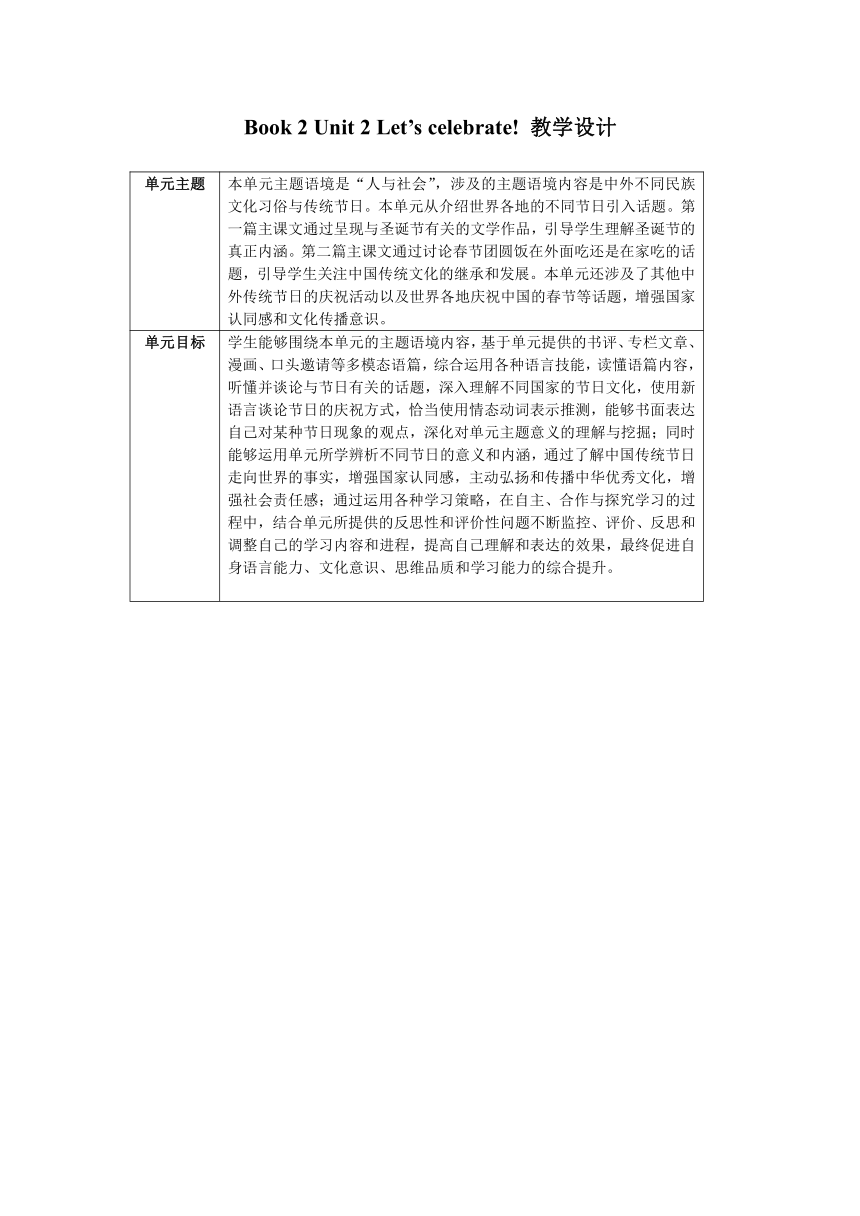 | |
| 格式 | docx | ||
| 文件大小 | 44.3KB | ||
| 资源类型 | 教案 | ||
| 版本资源 | 外研版(2019) | ||
| 科目 | 英语 | ||
| 更新时间 | 2022-09-01 15:39:32 | ||
图片预览

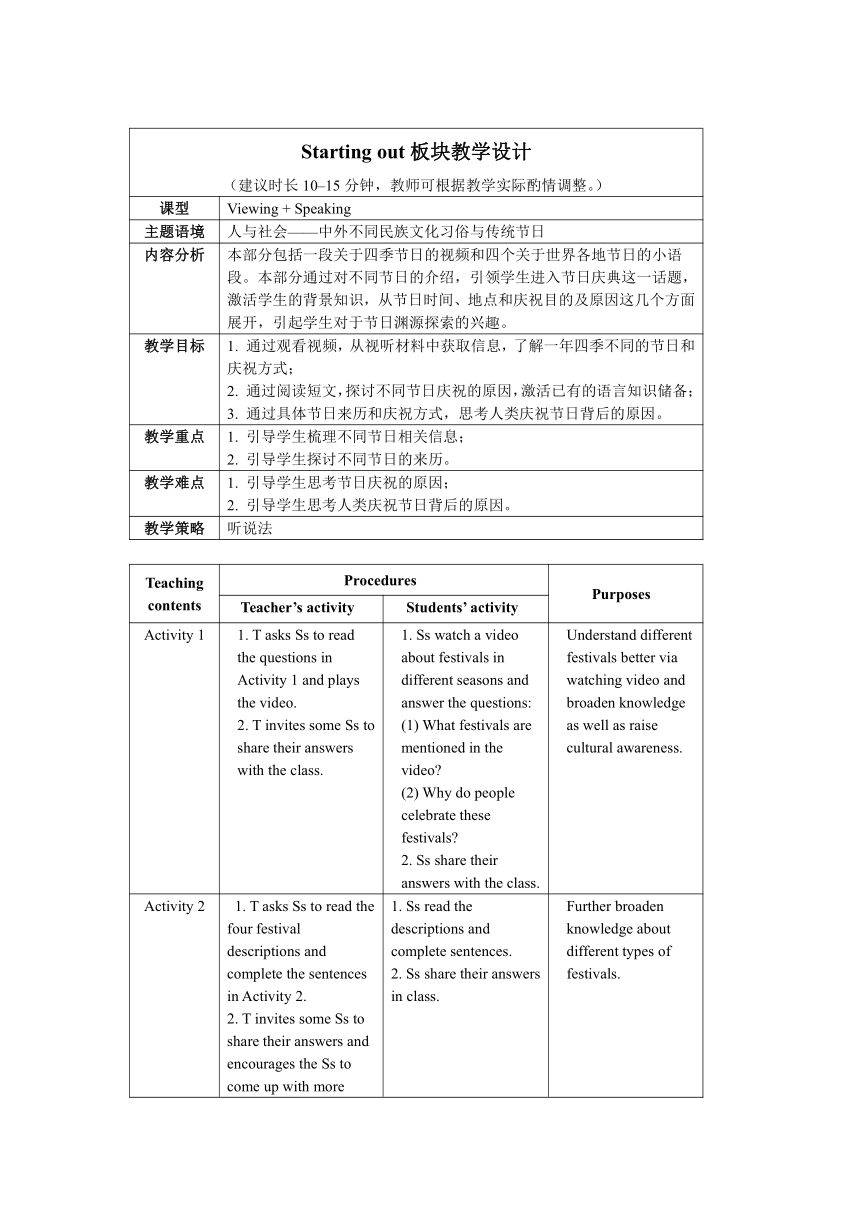
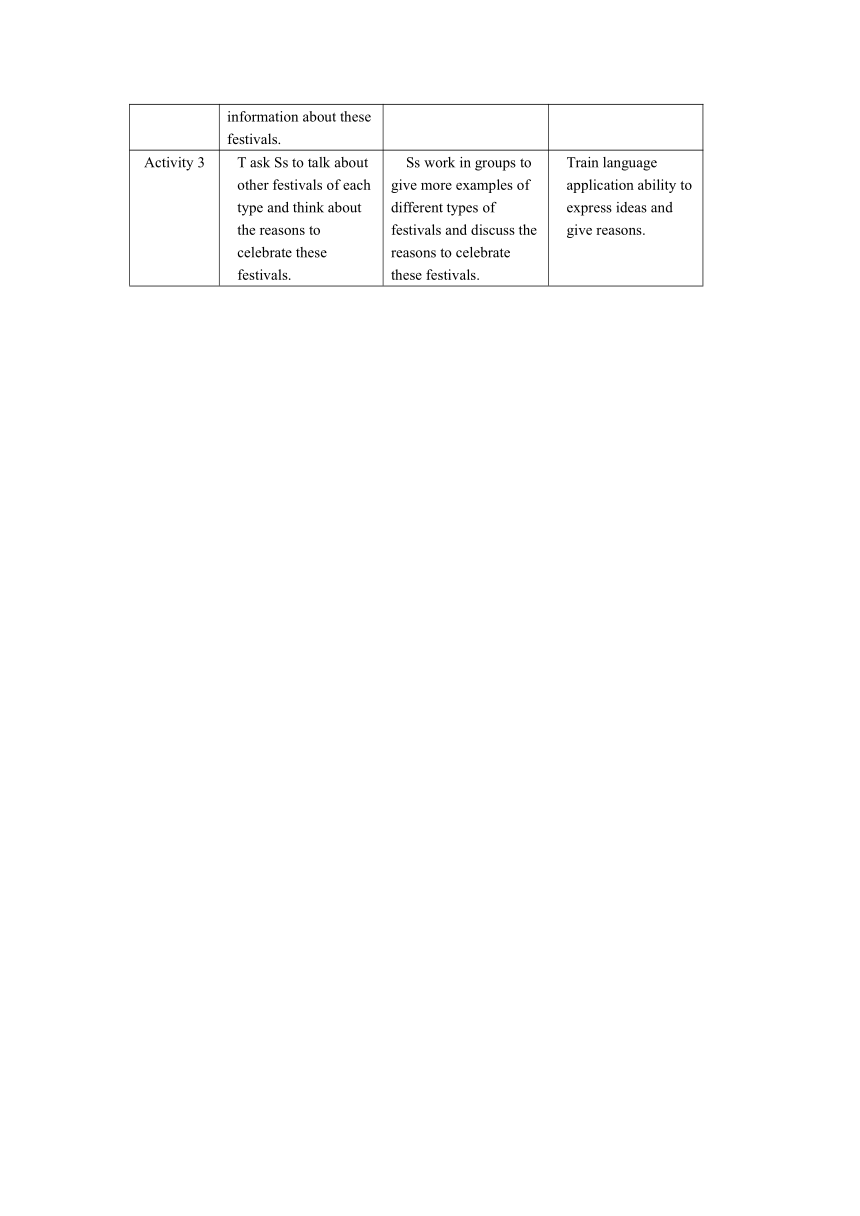
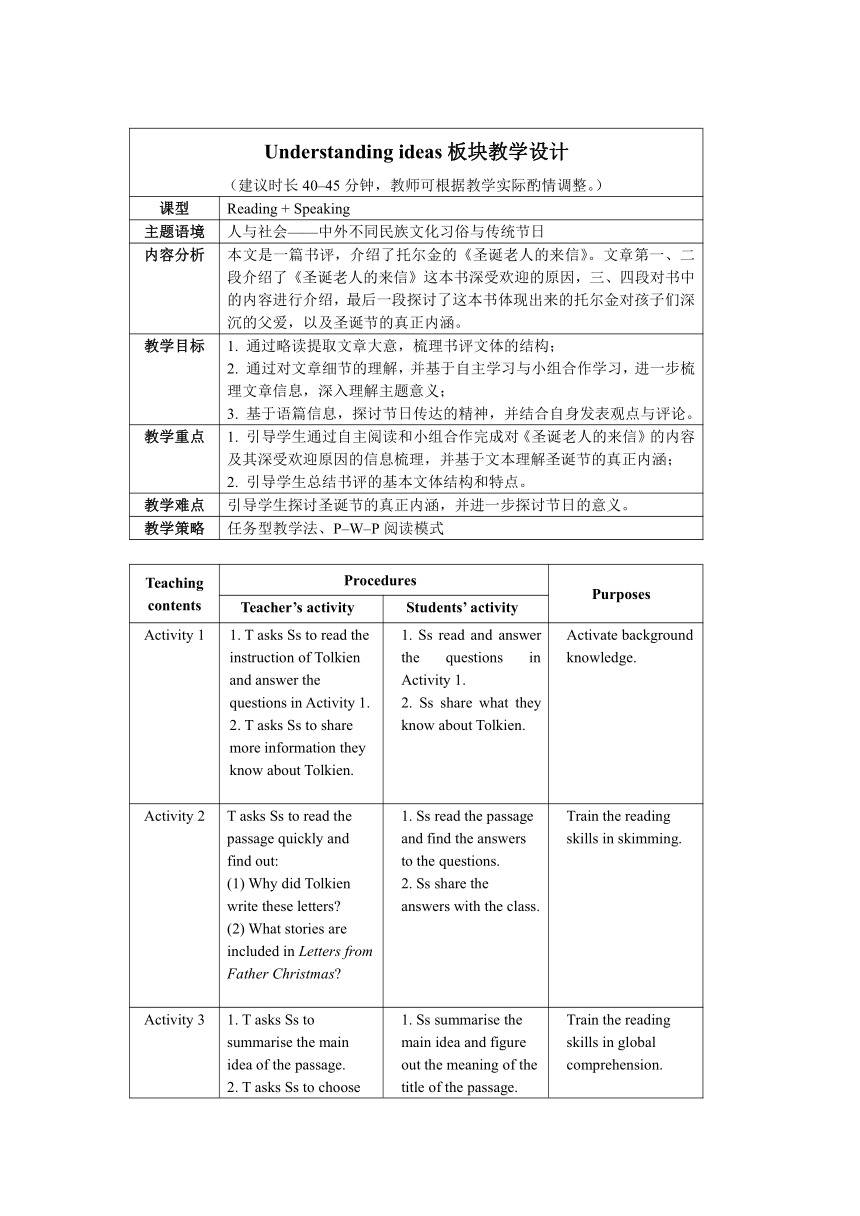
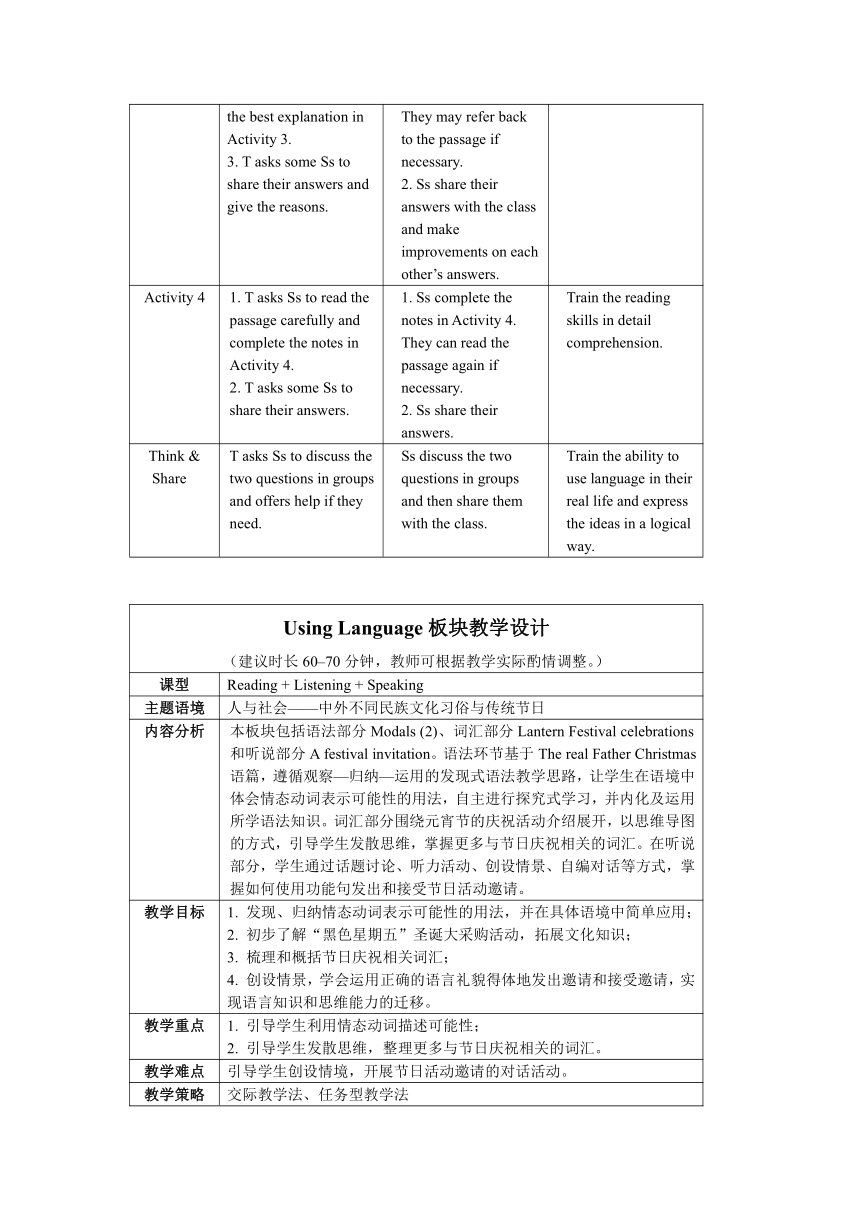
文档简介
Book 2 Unit 2 Let’s celebrate! 教学设计
单元主题 本单元主题语境是“人与社会”,涉及的主题语境内容是中外不同民族文化习俗与传统节日。本单元从介绍世界各地的不同节日引入话题。第一篇主课文通过呈现与圣诞节有关的文学作品,引导学生理解圣诞节的真正内涵。第二篇主课文通过讨论春节团圆饭在外面吃还是在家吃的话题,引导学生关注中国传统文化的继承和发展。本单元还涉及了其他中外传统节日的庆祝活动以及世界各地庆祝中国的春节等话题,增强国家认同感和文化传播意识。
单元目标 学生能够围绕本单元的主题语境内容,基于单元提供的书评、专栏文章、漫画、口头邀请等多模态语篇,综合运用各种语言技能,读懂语篇内容,听懂并谈论与节日有关的话题,深入理解不同国家的节日文化,使用新语言谈论节日的庆祝方式,恰当使用情态动词表示推测,能够书面表达自己对某种节日现象的观点,深化对单元主题意义的理解与挖掘;同时能够运用单元所学辨析不同节日的意义和内涵,通过了解中国传统节日走向世界的事实,增强国家认同感,主动弘扬和传播中华优秀文化,增强社会责任感;通过运用各种学习策略,在自主、合作与探究学习的过程中,结合单元所提供的反思性和评价性问题不断监控、评价、反思和调整自己的学习内容和进程,提高自己理解和表达的效果,最终促进自身语言能力、文化意识、思维品质和学习能力的综合提升。
Starting out板块教学设计 (建议时长10–15分钟,教师可根据教学实际酌情调整。)
课型 Viewing + Speaking
主题语境 人与社会——中外不同民族文化习俗与传统节日
内容分析 本部分包括一段关于四季节日的视频和四个关于世界各地节日的小语段。本部分通过对不同节日的介绍,引领学生进入节日庆典这一话题,激活学生的背景知识,从节日时间、地点和庆祝目的及原因这几个方面展开,引起学生对于节日渊源探索的兴趣。
教学目标 1. 通过观看视频,从视听材料中获取信息,了解一年四季不同的节日和庆祝方式; 2. 通过阅读短文,探讨不同节日庆祝的原因,激活已有的语言知识储备; 3. 通过具体节日来历和庆祝方式,思考人类庆祝节日背后的原因。
教学重点 1. 引导学生梳理不同节日相关信息; 2. 引导学生探讨不同节日的来历。
教学难点 1. 引导学生思考节日庆祝的原因; 2. 引导学生思考人类庆祝节日背后的原因。
教学策略 听说法
Teaching contents Procedures Purposes
Teacher’s activity Students’ activity
Activity 1 1. T asks Ss to read the questions in Activity 1 and plays the video. 2. T invites some Ss to share their answers with the class. 1. Ss watch a video about festivals in different seasons and answer the questions: (1) What festivals are mentioned in the video (2) Why do people celebrate these festivals 2. Ss share their answers with the class. Understand different festivals better via watching video and broaden knowledge as well as raise cultural awareness.
Activity 2 1. T asks Ss to read the four festival descriptions and complete the sentences in Activity 2. 2. T invites some Ss to share their answers and encourages the Ss to come up with more information about these festivals. 1. Ss read the descriptions and complete sentences. 2. Ss share their answers in class. Further broaden knowledge about different types of festivals.
Activity 3 T ask Ss to talk about other festivals of each type and think about the reasons to celebrate these festivals. Ss work in groups to give more examples of different types of festivals and discuss the reasons to celebrate these festivals. Train language application ability to express ideas and give reasons.
Understanding ideas板块教学设计 (建议时长40–45分钟,教师可根据教学实际酌情调整。)
课型 Reading + Speaking
主题语境 人与社会——中外不同民族文化习俗与传统节日
内容分析 本文是一篇书评,介绍了托尔金的《圣诞老人的来信》。文章第一、二段介绍了《圣诞老人的来信》这本书深受欢迎的原因,三、四段对书中的内容进行介绍,最后一段探讨了这本书体现出来的托尔金对孩子们深沉的父爱,以及圣诞节的真正内涵。
教学目标 1. 通过略读提取文章大意,梳理书评文体的结构; 2. 通过对文章细节的理解,并基于自主学习与小组合作学习,进一步梳理文章信息,深入理解主题意义; 3. 基于语篇信息,探讨节日传达的精神,并结合自身发表观点与评论。
教学重点 1. 引导学生通过自主阅读和小组合作完成对《圣诞老人的来信》的内容及其深受欢迎原因的信息梳理,并基于文本理解圣诞节的真正内涵; 2. 引导学生总结书评的基本文体结构和特点。
教学难点 引导学生探讨圣诞节的真正内涵,并进一步探讨节日的意义。
教学策略 任务型教学法、P–W–P阅读模式
Teaching contents Procedures Purposes
Teacher’s activity Students’ activity
Activity 1 1. T asks Ss to read the instruction of Tolkien and answer the questions in Activity 1. 2. T asks Ss to share more information they know about Tolkien. 1. Ss read and answer the questions in Activity 1. 2. Ss share what they know about Tolkien. Activate background knowledge.
Activity 2 T asks Ss to read the passage quickly and find out: (1) Why did Tolkien write these letters (2) What stories are included in Letters from Father Christmas 1. Ss read the passage and find the answers to the questions. 2. Ss share the answers with the class. Train the reading skills in skimming.
Activity 3 1. T asks Ss to summarise the main idea of the passage. 2. T asks Ss to choose the best explanation in Activity 3. 3. T asks some Ss to share their answers and give the reasons. 1. Ss summarise the main idea and figure out the meaning of the title of the passage. They may refer back to the passage if necessary. 2. Ss share their answers with the class and make improvements on each other’s answers. Train the reading skills in global comprehension.
Activity 4 1. T asks Ss to read the passage carefully and complete the notes in Activity 4. 2. T asks some Ss to share their answers. 1. Ss complete the notes in Activity 4. They can read the passage again if necessary. 2. Ss share their answers. Train the reading skills in detail comprehension.
Think & Share T asks Ss to discuss the two questions in groups and offers help if they need. Ss discuss the two questions in groups and then share them with the class. Train the ability to use language in their real life and express the ideas in a logical way.
Using Language板块教学设计 (建议时长60–70分钟,教师可根据教学实际酌情调整。)
课型 Reading + Listening + Speaking
主题语境 人与社会——中外不同民族文化习俗与传统节日
内容分析 本板块包括语法部分Modals (2)、词汇部分Lantern Festival celebrations和听说部分A festival invitation。语法环节基于The real Father Christmas语篇,遵循观察—归纳—运用的发现式语法教学思路,让学生在语境中体会情态动词表示可能性的用法,自主进行探究式学习,并内化及运用所学语法知识。词汇部分围绕元宵节的庆祝活动介绍展开,以思维导图的方式,引导学生发散思维,掌握更多与节日庆祝相关的词汇。在听说部分,学生通过话题讨论、听力活动、创设情景、自编对话等方式,掌握如何使用功能句发出和接受节日活动邀请。
教学目标 1. 发现、归纳情态动词表示可能性的用法,并在具体语境中简单应用; 2. 初步了解“黑色星期五”圣诞大采购活动,拓展文化知识; 3. 梳理和概括节日庆祝相关词汇; 4. 创设情景,学会运用正确的语言礼貌得体地发出邀请和接受邀请,实现语言知识和思维能力的迁移。
教学重点 1. 引导学生利用情态动词描述可能性; 2. 引导学生发散思维,整理更多与节日庆祝相关的词汇。
教学难点 引导学生创设情境,开展节日活动邀请的对话活动。
教学策略 交际教学法、任务型教学法
Teaching contents Procedures Purposes
Teacher’s activity Students’ activity
Activity 1 1. T asks Ss to read the sentences in the box in Activity 1 and answer questions. 2. T asks Ss to read the passage again and find out more sentences with modals and figure out the usage of these modals. 1. Ss figure out the levels of possibility indicated by different modals by analysing the sentences in Activity 1. 2. Ss find out more sentences with modals in the passage. Figure out the possibility levels of modals and generalise the rules.
Activity 2 1. T asks Ss to read the conversation in Activity 2 and talk about what the people are doing. 2. T asks Ss to rewrite the underlined sentences. 3. T invites some Ss to read the conversation rewritten with modals in roles. 1. Ss read the passage in Activity 2 and rewrite the underlined sentences. 2. Ss read the conversation with new sentences in roles. Practise using the target grammar in a given situation.
Activity 3 1. T introduces Black Friday to the Ss and asks Ss to observe the picture. 2. T asks Ss to make sentences to describe the picture using modals in groups. 3. T invites some groups to share their sentences. 1. Ss work in groups to describe the picture with sentences containing modals. 2. Ss share their sentences with the class. Using the language in a more open context.
Activity 4 1. T asks Ss to underline the words and expressions about celebrations during the Lantern Festival in the speech bubbles. 2. T asks Ss to complete the mind map in groups and encourages them to come up with as many words as they can. 1. Ss read the speech bubbles in Activity 4 and find out the words and expressions about celebrations. 2. Ss work in groups and complete the mind map. Classify the topic-related words.
Activity 5 T asks Ss to talk about another festival celebration with the hint of the mind map. Ss describe another festival celebration with the hint of the mind map. Use topic-related words to describe a festival celebration.
Did you know T asks Ss to read the short passage in “Did you know ” on page 19 and find out the proper way of answering an invitation and the arriving time. Ss read the passage on page 19 and find out the proper way of answer an invitation and the arriving time. Know cross-cultural background information.
Activity 6 T asks Ss to listen to the conversation and complete the sentences with the correct ending. Ss listen for the first time to get the main idea of the conversation and complete the sentences with the correct ending. Train the listening ability to get the main idea in a quick way.
Activity 7 1. T asks Ss to read “Learning to learn” on this page and reminds Ss to pay special attention to the crucial information. 2. T plays the recording for the Ss to complete the notes in Activity 6. 3. T asks Ss to talk about what the speakers say to extend and accept an invitation in groups. Play the recording again if necessary. 1. Ss read “Learning to learn” on this page to get the point. 2. Ss listen for the second time and complete the notes. 3. Ss work in groups and talk about what the speakers say to extend and accept an invitation. Understand the details of the conversation and summarise the proper way of extending and accepting an invitation.
Activity 8 1. T asks Ss to turn to the corresponding pages and read the information. 2. T asks Ss to work in pairs and act out the conversation. 3. T invites some pairs to act out their conversations in class. 1. Ss read the information on the corresponding pages. 2. Ss work in pairs and act out the conversation using the useful expressions. 3. Ss act out their conversations in class. Use the useful expressions of extending and accepting an invitation to carry out a conversation.
Activity 8 T asks Ss to make another similar conversation. Ss make another similar conversation. Further practise extending and accepting an invitation.
Developing ideas板块教学设计 (建议时长80–90分钟,教师可根据教学实际酌情调整。)
课型 Reading + Writing
主题语境 人与社会——中外不同民族文化习俗与传统节日
内容分析 本板块首先呈现了本单元的第二个主要阅读语篇,是两封写给报纸专栏的读者来信,呈现了两个不同年龄、不同职业的人对年夜饭在哪里吃的两种不同看法。第一位读者认为在外吃年夜饭为人们提供了便利,让人们有更多的时间陪伴家人。第二位读者认为一家人一起准备年夜饭的过程是最珍贵的回忆。 写作部分对春节这一话题进一步延伸,要求学生针对世界各地庆祝中国的春节这一现象发表自己的评论。通过完成写作任务,学生能够了解中国节日逐渐走向世界的趋势,坚定文化自信,传播中国文化。
教学目标 1. 通过略读和详读了解对于年夜饭在哪里吃的两种不同观点,梳理和概括理由; 2. 理解不同观点体现的不同的价值观,增加对文化内涵的理解; 3. 能够对于不同观点做出自己的评价和判断,提高批判性思维能力。
教学重点 1. 引导学生读懂文章,分析两种不同观点产生的原因; 2. 引导学生对于不同观点做出自己的评论。
教学难点 引导学生基于对文章的理解,以书信形式论述中国节日走向世界的原因并发表自己的看法。
教学策略 交际教学法、任务型教学法
Teaching contents Procedures Purposes
Teacher’s activity Students’ activity
Activity 1 1. T asks Ss to look at the pictures in Activity 1 and talk about Chinese Spring Festival traditions. 2. T invites some Ss to come up with more traditions. 1. Ss look at the pictures in Activity 1 and talk about Chinese Spring Festival traditions. 2. Ss come up with more traditions and describe them. Activate background knowledge.
Activity 2 T asks Ss to read the passage quickly and find out each person’s point of view. Ss read the passage quickly and find out each person’s point of view. Skim and get the main idea of the passage.
Activity 3 1. T asks Ss to read “Learning to learn” and figure out what is a fact and what is an opinion. 2. T asks Ss to read the sentences from the passage in Activity 3 and decide if they are facts (F) or opinions (O). 1. Ss read “Learning to learn” and figure out what is a fact and what is an opinion. 2. Ss read the sentences from the passage in Activity 3 and decide if they are facts (F) or opinions (O). Distinguish facts from opinions.
Think & Share 1. T asks Ss to work in groups and discuss the four questions in “Think & Share”. 2. T invites some Ss to share their opinions. Ss discuss the four questions in groups and then share them with the class. Further understand the topic of the passage and make comments.
Activity 4 1. T asks Ss to think about the reasons why the Spring Festival family dinner means so much to us Chinese. 2. T helps Ss understand how to organise a talk about the importance of the Spring Festival family dinner. 3. T invites some Ss to give their talks in class. 1. Ss list the reasons why the Spring Festival family dinner means so much to us Chinese. 2. Ss work in groups and organise their talks. 3. Ss give their talks to the class. Improve critical thinking ability and consolidate the language and content learnt.
Activity 5 T asks Ss to read the editorial and answer the questions in Activity 5. Ss read the editorial and answer the following questions: (1) Which countries are mentioned and how do they celebrate Chinese Spring Festival (2) Which event would you most like to attend Why (3) Why do you think Chinese Spring Festival is “going global” (group work) Read for comprehension and analyse the reasons for Chinese Spring Festival’s going global.
Activity 6 1. T asks Ss to complete the notes according to their own ideas. 2. T reminds Ss to refer back to the reading passage on Page 20–21for the structure. 3. T shows the criteria of a good composition and asks Ss to write their own letters. 1. Ss complete the notes according to their own ideas. 2. Ss write their letters with the help of the notes. Practise writing about opinions based on giving information.
Activity 7 T asks some Ss to show their writing to the class, and invites other Ss to make improvement. 1. Ss share their writing with the class. 2. Ss do peer evaluation based on the criteria. Improve writing ability through peer evaluation.
Presenting ideas &Reflection板块教学设计 (Presenting ideas和Reflection部分建议总时长40–45分钟, 教师可根据教学实际酌情调整。)
课型 Speaking
主题语境 人与社会——中外不同民族文化习俗与传统节日
内容分析 Presenting ideas板块以主题节日庆祝为依托,围绕节日的创设开展探索式学习。学生首先了解书上给出的几个节日是因何创设的,从而进一步思考人类创设新节日的原因,然后创造一个自己认为重要的节日,在思考与表达的过程中提高创新思维能力。 Reflection板块为本单元的反思总结环节,学生全面回顾自己在学习本单元过程中的表现,分析自己的收获与不足。
教学目标 1. 通过查找资料,分析世界卫生日、世界读书日和世界微笑日的具体信息和创设原因,梳理概括人类创设新节日的原因; 2. 创造一个新的节日,并能阐述原因,锻炼创新思维能力; 3. 通过自我反思的方式,监控、评价、反思和调整自己学习内容和进度。
教学重点 1. 引导学生思考人类创设节日的原因; 2. 引导学生从语言能力、思维品质等方面对自己在本单元学习过程中和结束时的学习行为和效果做出合理的评价。
教学难点 1. 引导学生基于对节日庆祝原因的分析,创设一个新的节日,并向全班介绍该节日; 2. 引导学生养成自我评价的好习惯。
教学策略 元认知策略、认知策略、交际策略和情感策略
Teaching contents Procedures Purposes
Teacher’s activity Students’ activity
Presenting ideas
Activity 1 1. T asks Ss to look at the pictures and do research on the special days. 2. T asks Ss to introduce what they’ve found about these days, including the reasons for their creation. 1. Ss do research on the special days in Activity 1 and find out the reasons for the creation of these days. Prepare for the presentation.
Activity 2 T asks Ss to think of a special day and complete the table. Ss think of a special day they would like to create using the table to help organise their ideas. Create a special day and organise ideas.
Activity 3 1. T asks Ss to work in groups and share their special days. 2. T reminds Ss to follow the steps in Activity 3 and prepare for their group presentation. Ss work in groups and organise their presentation following the steps below: (1) Say what day you would like to create and when it is. (2) State why you would like to create it. (3) Talk about special activities to celebrate it. Organise presentation
Activity 4 1. T invites some groups to do presentations in class. 2. T asks Ss to vote for the best suggestions. 1. Ss present their special days in class. 2. Ss vote for the best suggestions. Practise skills in giving a presentation, and learn from each other.
Reflection
Reflection 1. T asks Ss to recall what they’ve learnt in this unit. 2. T asks Ss to complete “Reflection” on page 24. Ss rate their performance in this unit, summarise what they’ve learnt and think about what they need to improve. Rate performance, review the unit, and think about ways to improve.
Project板块教学设计 (此部分教师可根据教学实际酌情调整。)
课型 Speaking
主题语境 人与社会——中外不同民族文化习俗与传统节日
内容分析 本项目实践活动以主题节日庆祝为依托,围绕世界各地节日展开。学生用书的活动步骤启迪思路,激发学生寻找自己感兴趣的节日,调查其起源、历史和庆祝方式等,并基于调查内容设计宣传海报。通过实践调查方式,学生能够增强对更多节日文化的了解,并提高搜集整理信息的能力以及创造性思维能力。
教学目标 1. 从兴趣出发,多渠道获取节日相关信息; 2. 将所学知识迁移运用,全面系统地介绍节日; 3. 自主探究并小组合作制作节日海报,并以小组为单位向班级展示合作成果。
教学重点 1. 引导学生利用单元所学,上网查找资料,多渠道获取信息; 2. 引导学生进一步了解节日的内涵。
教学难点 引导学生明确小组分工,制作节日海报。
教学策略 任务型教学法
Teaching contents Procedures Purposes
Teacher’s activity Students’ activity
Investigate T asks Ss to share the festival information they have investigated before class with group members. Ss work in groups and share the information about the chosen festival. Develop skills in searching information.
Plan T asks Ss to organise the information into categories for their posters. 1. Ss work in groups and organise the information into categories for their posters, including: (1) Why is the festival celebrated (2) When and how often is it celebrated (3) What are its origins and history (4) How has it changed over time Organise the structure of a poster.
Create 1. T asks Ss to write a short paragraph about each piece of information, and find some pictures accordingly. 2. While Ss making their posters, T provides guidance to Ss if necessary. Ss make their posters in groups after class. Practise group work.
Present T arranges time in later periods for Ss to show their posters to the class and do presentations. 1. Each group show their poster to the class and do presentation. 2. Ss make comments on each group’s poster. Practise skills in giving a presentation, and learn from each other.
单元主题 本单元主题语境是“人与社会”,涉及的主题语境内容是中外不同民族文化习俗与传统节日。本单元从介绍世界各地的不同节日引入话题。第一篇主课文通过呈现与圣诞节有关的文学作品,引导学生理解圣诞节的真正内涵。第二篇主课文通过讨论春节团圆饭在外面吃还是在家吃的话题,引导学生关注中国传统文化的继承和发展。本单元还涉及了其他中外传统节日的庆祝活动以及世界各地庆祝中国的春节等话题,增强国家认同感和文化传播意识。
单元目标 学生能够围绕本单元的主题语境内容,基于单元提供的书评、专栏文章、漫画、口头邀请等多模态语篇,综合运用各种语言技能,读懂语篇内容,听懂并谈论与节日有关的话题,深入理解不同国家的节日文化,使用新语言谈论节日的庆祝方式,恰当使用情态动词表示推测,能够书面表达自己对某种节日现象的观点,深化对单元主题意义的理解与挖掘;同时能够运用单元所学辨析不同节日的意义和内涵,通过了解中国传统节日走向世界的事实,增强国家认同感,主动弘扬和传播中华优秀文化,增强社会责任感;通过运用各种学习策略,在自主、合作与探究学习的过程中,结合单元所提供的反思性和评价性问题不断监控、评价、反思和调整自己的学习内容和进程,提高自己理解和表达的效果,最终促进自身语言能力、文化意识、思维品质和学习能力的综合提升。
Starting out板块教学设计 (建议时长10–15分钟,教师可根据教学实际酌情调整。)
课型 Viewing + Speaking
主题语境 人与社会——中外不同民族文化习俗与传统节日
内容分析 本部分包括一段关于四季节日的视频和四个关于世界各地节日的小语段。本部分通过对不同节日的介绍,引领学生进入节日庆典这一话题,激活学生的背景知识,从节日时间、地点和庆祝目的及原因这几个方面展开,引起学生对于节日渊源探索的兴趣。
教学目标 1. 通过观看视频,从视听材料中获取信息,了解一年四季不同的节日和庆祝方式; 2. 通过阅读短文,探讨不同节日庆祝的原因,激活已有的语言知识储备; 3. 通过具体节日来历和庆祝方式,思考人类庆祝节日背后的原因。
教学重点 1. 引导学生梳理不同节日相关信息; 2. 引导学生探讨不同节日的来历。
教学难点 1. 引导学生思考节日庆祝的原因; 2. 引导学生思考人类庆祝节日背后的原因。
教学策略 听说法
Teaching contents Procedures Purposes
Teacher’s activity Students’ activity
Activity 1 1. T asks Ss to read the questions in Activity 1 and plays the video. 2. T invites some Ss to share their answers with the class. 1. Ss watch a video about festivals in different seasons and answer the questions: (1) What festivals are mentioned in the video (2) Why do people celebrate these festivals 2. Ss share their answers with the class. Understand different festivals better via watching video and broaden knowledge as well as raise cultural awareness.
Activity 2 1. T asks Ss to read the four festival descriptions and complete the sentences in Activity 2. 2. T invites some Ss to share their answers and encourages the Ss to come up with more information about these festivals. 1. Ss read the descriptions and complete sentences. 2. Ss share their answers in class. Further broaden knowledge about different types of festivals.
Activity 3 T ask Ss to talk about other festivals of each type and think about the reasons to celebrate these festivals. Ss work in groups to give more examples of different types of festivals and discuss the reasons to celebrate these festivals. Train language application ability to express ideas and give reasons.
Understanding ideas板块教学设计 (建议时长40–45分钟,教师可根据教学实际酌情调整。)
课型 Reading + Speaking
主题语境 人与社会——中外不同民族文化习俗与传统节日
内容分析 本文是一篇书评,介绍了托尔金的《圣诞老人的来信》。文章第一、二段介绍了《圣诞老人的来信》这本书深受欢迎的原因,三、四段对书中的内容进行介绍,最后一段探讨了这本书体现出来的托尔金对孩子们深沉的父爱,以及圣诞节的真正内涵。
教学目标 1. 通过略读提取文章大意,梳理书评文体的结构; 2. 通过对文章细节的理解,并基于自主学习与小组合作学习,进一步梳理文章信息,深入理解主题意义; 3. 基于语篇信息,探讨节日传达的精神,并结合自身发表观点与评论。
教学重点 1. 引导学生通过自主阅读和小组合作完成对《圣诞老人的来信》的内容及其深受欢迎原因的信息梳理,并基于文本理解圣诞节的真正内涵; 2. 引导学生总结书评的基本文体结构和特点。
教学难点 引导学生探讨圣诞节的真正内涵,并进一步探讨节日的意义。
教学策略 任务型教学法、P–W–P阅读模式
Teaching contents Procedures Purposes
Teacher’s activity Students’ activity
Activity 1 1. T asks Ss to read the instruction of Tolkien and answer the questions in Activity 1. 2. T asks Ss to share more information they know about Tolkien. 1. Ss read and answer the questions in Activity 1. 2. Ss share what they know about Tolkien. Activate background knowledge.
Activity 2 T asks Ss to read the passage quickly and find out: (1) Why did Tolkien write these letters (2) What stories are included in Letters from Father Christmas 1. Ss read the passage and find the answers to the questions. 2. Ss share the answers with the class. Train the reading skills in skimming.
Activity 3 1. T asks Ss to summarise the main idea of the passage. 2. T asks Ss to choose the best explanation in Activity 3. 3. T asks some Ss to share their answers and give the reasons. 1. Ss summarise the main idea and figure out the meaning of the title of the passage. They may refer back to the passage if necessary. 2. Ss share their answers with the class and make improvements on each other’s answers. Train the reading skills in global comprehension.
Activity 4 1. T asks Ss to read the passage carefully and complete the notes in Activity 4. 2. T asks some Ss to share their answers. 1. Ss complete the notes in Activity 4. They can read the passage again if necessary. 2. Ss share their answers. Train the reading skills in detail comprehension.
Think & Share T asks Ss to discuss the two questions in groups and offers help if they need. Ss discuss the two questions in groups and then share them with the class. Train the ability to use language in their real life and express the ideas in a logical way.
Using Language板块教学设计 (建议时长60–70分钟,教师可根据教学实际酌情调整。)
课型 Reading + Listening + Speaking
主题语境 人与社会——中外不同民族文化习俗与传统节日
内容分析 本板块包括语法部分Modals (2)、词汇部分Lantern Festival celebrations和听说部分A festival invitation。语法环节基于The real Father Christmas语篇,遵循观察—归纳—运用的发现式语法教学思路,让学生在语境中体会情态动词表示可能性的用法,自主进行探究式学习,并内化及运用所学语法知识。词汇部分围绕元宵节的庆祝活动介绍展开,以思维导图的方式,引导学生发散思维,掌握更多与节日庆祝相关的词汇。在听说部分,学生通过话题讨论、听力活动、创设情景、自编对话等方式,掌握如何使用功能句发出和接受节日活动邀请。
教学目标 1. 发现、归纳情态动词表示可能性的用法,并在具体语境中简单应用; 2. 初步了解“黑色星期五”圣诞大采购活动,拓展文化知识; 3. 梳理和概括节日庆祝相关词汇; 4. 创设情景,学会运用正确的语言礼貌得体地发出邀请和接受邀请,实现语言知识和思维能力的迁移。
教学重点 1. 引导学生利用情态动词描述可能性; 2. 引导学生发散思维,整理更多与节日庆祝相关的词汇。
教学难点 引导学生创设情境,开展节日活动邀请的对话活动。
教学策略 交际教学法、任务型教学法
Teaching contents Procedures Purposes
Teacher’s activity Students’ activity
Activity 1 1. T asks Ss to read the sentences in the box in Activity 1 and answer questions. 2. T asks Ss to read the passage again and find out more sentences with modals and figure out the usage of these modals. 1. Ss figure out the levels of possibility indicated by different modals by analysing the sentences in Activity 1. 2. Ss find out more sentences with modals in the passage. Figure out the possibility levels of modals and generalise the rules.
Activity 2 1. T asks Ss to read the conversation in Activity 2 and talk about what the people are doing. 2. T asks Ss to rewrite the underlined sentences. 3. T invites some Ss to read the conversation rewritten with modals in roles. 1. Ss read the passage in Activity 2 and rewrite the underlined sentences. 2. Ss read the conversation with new sentences in roles. Practise using the target grammar in a given situation.
Activity 3 1. T introduces Black Friday to the Ss and asks Ss to observe the picture. 2. T asks Ss to make sentences to describe the picture using modals in groups. 3. T invites some groups to share their sentences. 1. Ss work in groups to describe the picture with sentences containing modals. 2. Ss share their sentences with the class. Using the language in a more open context.
Activity 4 1. T asks Ss to underline the words and expressions about celebrations during the Lantern Festival in the speech bubbles. 2. T asks Ss to complete the mind map in groups and encourages them to come up with as many words as they can. 1. Ss read the speech bubbles in Activity 4 and find out the words and expressions about celebrations. 2. Ss work in groups and complete the mind map. Classify the topic-related words.
Activity 5 T asks Ss to talk about another festival celebration with the hint of the mind map. Ss describe another festival celebration with the hint of the mind map. Use topic-related words to describe a festival celebration.
Did you know T asks Ss to read the short passage in “Did you know ” on page 19 and find out the proper way of answering an invitation and the arriving time. Ss read the passage on page 19 and find out the proper way of answer an invitation and the arriving time. Know cross-cultural background information.
Activity 6 T asks Ss to listen to the conversation and complete the sentences with the correct ending. Ss listen for the first time to get the main idea of the conversation and complete the sentences with the correct ending. Train the listening ability to get the main idea in a quick way.
Activity 7 1. T asks Ss to read “Learning to learn” on this page and reminds Ss to pay special attention to the crucial information. 2. T plays the recording for the Ss to complete the notes in Activity 6. 3. T asks Ss to talk about what the speakers say to extend and accept an invitation in groups. Play the recording again if necessary. 1. Ss read “Learning to learn” on this page to get the point. 2. Ss listen for the second time and complete the notes. 3. Ss work in groups and talk about what the speakers say to extend and accept an invitation. Understand the details of the conversation and summarise the proper way of extending and accepting an invitation.
Activity 8 1. T asks Ss to turn to the corresponding pages and read the information. 2. T asks Ss to work in pairs and act out the conversation. 3. T invites some pairs to act out their conversations in class. 1. Ss read the information on the corresponding pages. 2. Ss work in pairs and act out the conversation using the useful expressions. 3. Ss act out their conversations in class. Use the useful expressions of extending and accepting an invitation to carry out a conversation.
Activity 8 T asks Ss to make another similar conversation. Ss make another similar conversation. Further practise extending and accepting an invitation.
Developing ideas板块教学设计 (建议时长80–90分钟,教师可根据教学实际酌情调整。)
课型 Reading + Writing
主题语境 人与社会——中外不同民族文化习俗与传统节日
内容分析 本板块首先呈现了本单元的第二个主要阅读语篇,是两封写给报纸专栏的读者来信,呈现了两个不同年龄、不同职业的人对年夜饭在哪里吃的两种不同看法。第一位读者认为在外吃年夜饭为人们提供了便利,让人们有更多的时间陪伴家人。第二位读者认为一家人一起准备年夜饭的过程是最珍贵的回忆。 写作部分对春节这一话题进一步延伸,要求学生针对世界各地庆祝中国的春节这一现象发表自己的评论。通过完成写作任务,学生能够了解中国节日逐渐走向世界的趋势,坚定文化自信,传播中国文化。
教学目标 1. 通过略读和详读了解对于年夜饭在哪里吃的两种不同观点,梳理和概括理由; 2. 理解不同观点体现的不同的价值观,增加对文化内涵的理解; 3. 能够对于不同观点做出自己的评价和判断,提高批判性思维能力。
教学重点 1. 引导学生读懂文章,分析两种不同观点产生的原因; 2. 引导学生对于不同观点做出自己的评论。
教学难点 引导学生基于对文章的理解,以书信形式论述中国节日走向世界的原因并发表自己的看法。
教学策略 交际教学法、任务型教学法
Teaching contents Procedures Purposes
Teacher’s activity Students’ activity
Activity 1 1. T asks Ss to look at the pictures in Activity 1 and talk about Chinese Spring Festival traditions. 2. T invites some Ss to come up with more traditions. 1. Ss look at the pictures in Activity 1 and talk about Chinese Spring Festival traditions. 2. Ss come up with more traditions and describe them. Activate background knowledge.
Activity 2 T asks Ss to read the passage quickly and find out each person’s point of view. Ss read the passage quickly and find out each person’s point of view. Skim and get the main idea of the passage.
Activity 3 1. T asks Ss to read “Learning to learn” and figure out what is a fact and what is an opinion. 2. T asks Ss to read the sentences from the passage in Activity 3 and decide if they are facts (F) or opinions (O). 1. Ss read “Learning to learn” and figure out what is a fact and what is an opinion. 2. Ss read the sentences from the passage in Activity 3 and decide if they are facts (F) or opinions (O). Distinguish facts from opinions.
Think & Share 1. T asks Ss to work in groups and discuss the four questions in “Think & Share”. 2. T invites some Ss to share their opinions. Ss discuss the four questions in groups and then share them with the class. Further understand the topic of the passage and make comments.
Activity 4 1. T asks Ss to think about the reasons why the Spring Festival family dinner means so much to us Chinese. 2. T helps Ss understand how to organise a talk about the importance of the Spring Festival family dinner. 3. T invites some Ss to give their talks in class. 1. Ss list the reasons why the Spring Festival family dinner means so much to us Chinese. 2. Ss work in groups and organise their talks. 3. Ss give their talks to the class. Improve critical thinking ability and consolidate the language and content learnt.
Activity 5 T asks Ss to read the editorial and answer the questions in Activity 5. Ss read the editorial and answer the following questions: (1) Which countries are mentioned and how do they celebrate Chinese Spring Festival (2) Which event would you most like to attend Why (3) Why do you think Chinese Spring Festival is “going global” (group work) Read for comprehension and analyse the reasons for Chinese Spring Festival’s going global.
Activity 6 1. T asks Ss to complete the notes according to their own ideas. 2. T reminds Ss to refer back to the reading passage on Page 20–21for the structure. 3. T shows the criteria of a good composition and asks Ss to write their own letters. 1. Ss complete the notes according to their own ideas. 2. Ss write their letters with the help of the notes. Practise writing about opinions based on giving information.
Activity 7 T asks some Ss to show their writing to the class, and invites other Ss to make improvement. 1. Ss share their writing with the class. 2. Ss do peer evaluation based on the criteria. Improve writing ability through peer evaluation.
Presenting ideas &Reflection板块教学设计 (Presenting ideas和Reflection部分建议总时长40–45分钟, 教师可根据教学实际酌情调整。)
课型 Speaking
主题语境 人与社会——中外不同民族文化习俗与传统节日
内容分析 Presenting ideas板块以主题节日庆祝为依托,围绕节日的创设开展探索式学习。学生首先了解书上给出的几个节日是因何创设的,从而进一步思考人类创设新节日的原因,然后创造一个自己认为重要的节日,在思考与表达的过程中提高创新思维能力。 Reflection板块为本单元的反思总结环节,学生全面回顾自己在学习本单元过程中的表现,分析自己的收获与不足。
教学目标 1. 通过查找资料,分析世界卫生日、世界读书日和世界微笑日的具体信息和创设原因,梳理概括人类创设新节日的原因; 2. 创造一个新的节日,并能阐述原因,锻炼创新思维能力; 3. 通过自我反思的方式,监控、评价、反思和调整自己学习内容和进度。
教学重点 1. 引导学生思考人类创设节日的原因; 2. 引导学生从语言能力、思维品质等方面对自己在本单元学习过程中和结束时的学习行为和效果做出合理的评价。
教学难点 1. 引导学生基于对节日庆祝原因的分析,创设一个新的节日,并向全班介绍该节日; 2. 引导学生养成自我评价的好习惯。
教学策略 元认知策略、认知策略、交际策略和情感策略
Teaching contents Procedures Purposes
Teacher’s activity Students’ activity
Presenting ideas
Activity 1 1. T asks Ss to look at the pictures and do research on the special days. 2. T asks Ss to introduce what they’ve found about these days, including the reasons for their creation. 1. Ss do research on the special days in Activity 1 and find out the reasons for the creation of these days. Prepare for the presentation.
Activity 2 T asks Ss to think of a special day and complete the table. Ss think of a special day they would like to create using the table to help organise their ideas. Create a special day and organise ideas.
Activity 3 1. T asks Ss to work in groups and share their special days. 2. T reminds Ss to follow the steps in Activity 3 and prepare for their group presentation. Ss work in groups and organise their presentation following the steps below: (1) Say what day you would like to create and when it is. (2) State why you would like to create it. (3) Talk about special activities to celebrate it. Organise presentation
Activity 4 1. T invites some groups to do presentations in class. 2. T asks Ss to vote for the best suggestions. 1. Ss present their special days in class. 2. Ss vote for the best suggestions. Practise skills in giving a presentation, and learn from each other.
Reflection
Reflection 1. T asks Ss to recall what they’ve learnt in this unit. 2. T asks Ss to complete “Reflection” on page 24. Ss rate their performance in this unit, summarise what they’ve learnt and think about what they need to improve. Rate performance, review the unit, and think about ways to improve.
Project板块教学设计 (此部分教师可根据教学实际酌情调整。)
课型 Speaking
主题语境 人与社会——中外不同民族文化习俗与传统节日
内容分析 本项目实践活动以主题节日庆祝为依托,围绕世界各地节日展开。学生用书的活动步骤启迪思路,激发学生寻找自己感兴趣的节日,调查其起源、历史和庆祝方式等,并基于调查内容设计宣传海报。通过实践调查方式,学生能够增强对更多节日文化的了解,并提高搜集整理信息的能力以及创造性思维能力。
教学目标 1. 从兴趣出发,多渠道获取节日相关信息; 2. 将所学知识迁移运用,全面系统地介绍节日; 3. 自主探究并小组合作制作节日海报,并以小组为单位向班级展示合作成果。
教学重点 1. 引导学生利用单元所学,上网查找资料,多渠道获取信息; 2. 引导学生进一步了解节日的内涵。
教学难点 引导学生明确小组分工,制作节日海报。
教学策略 任务型教学法
Teaching contents Procedures Purposes
Teacher’s activity Students’ activity
Investigate T asks Ss to share the festival information they have investigated before class with group members. Ss work in groups and share the information about the chosen festival. Develop skills in searching information.
Plan T asks Ss to organise the information into categories for their posters. 1. Ss work in groups and organise the information into categories for their posters, including: (1) Why is the festival celebrated (2) When and how often is it celebrated (3) What are its origins and history (4) How has it changed over time Organise the structure of a poster.
Create 1. T asks Ss to write a short paragraph about each piece of information, and find some pictures accordingly. 2. While Ss making their posters, T provides guidance to Ss if necessary. Ss make their posters in groups after class. Practise group work.
Present T arranges time in later periods for Ss to show their posters to the class and do presentations. 1. Each group show their poster to the class and do presentation. 2. Ss make comments on each group’s poster. Practise skills in giving a presentation, and learn from each other.
